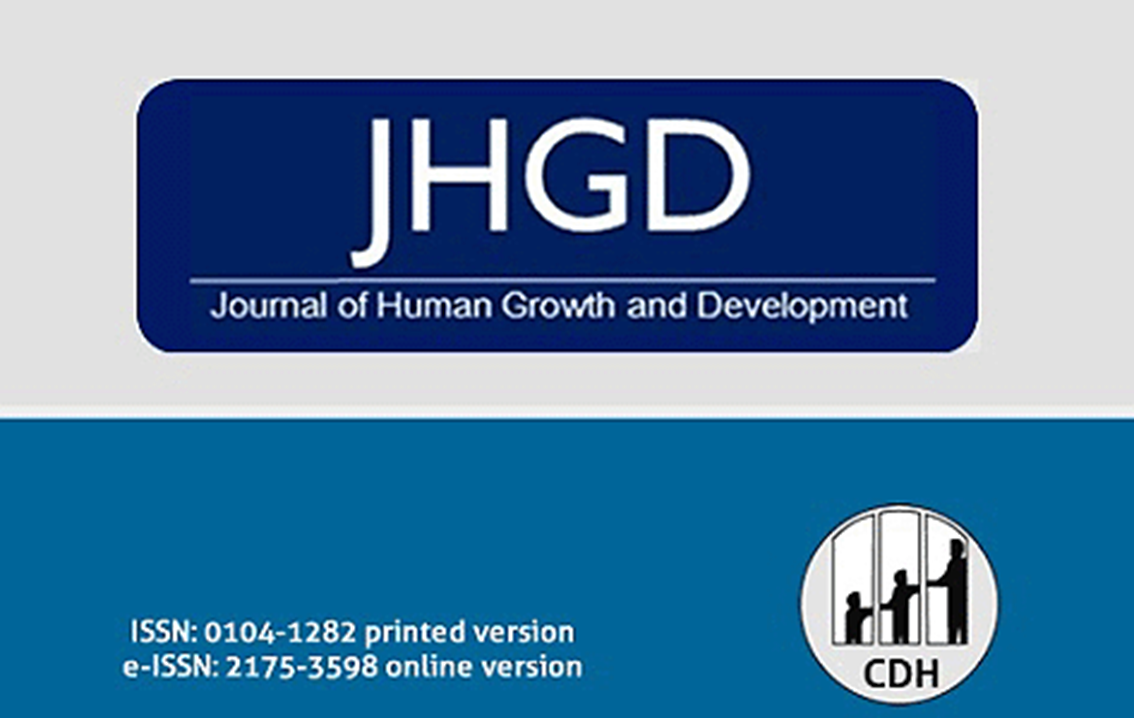Effect of object weight and experience on the organization of object management tasks in infants of 10 months of age
DOI:
https://doi.org/10.7322/jhgd.v29.9419Keywords:
infant behavior, motor skills, infantAbstract
Introduction: Little is known about the real impact the practice of manipulating objects on the development of infants perception-action and it is assumed that this newly acquired knowledge is useful for planning future actions. Objective: To analyse the effects of controlled practice on the tasks of reaching and transporting objects in 10-month-old infants when the weight of the object was changed. Methods: Sixteen infants were divided into two groups: heavy/ light group (HLG) and light/heavy group (LHG). The task consisted in reaching, grasping, and lifting a lighter or heavier bar 9 times. On the tenth trial, the object weight was switched to the heavier or lighter weight object (whichever was opposite to the object weight experienced in the first 9 trials) to assess whether infants had learned and adapted their object-directed movement strength to the initial weight condition practiced during the first 9 trials. Results: No significant differences were found when comparing the reaching and lifting phases within groups (LHG, P = 0.06 and HLG, p = 0.41). However, group comparisons revealed that HLG infants presented increased velocity peak (p = 0.01) during the trials. Conclusion: The reaching and object lifting trials of the infants throughout the attempts were very variable, indicating that, possibly, at 10 months of age, infants present transitions from one organizational state to another. However, it is necessary to carry out more detailed investigations on reaching and lifting actions of objects to understand the processes involved in these transition periods.
Downloads
References
2. Newell KM, Jordan K. Task Constraints and Movement Organization: A Common Language. In: Davis WE. Ecological task analysis and movement. Human Kinetics, 2007; p. 5-23.
3. Hopkins B, Butterworth G. Dynamical systems approaches to the development of action. In: Bremner G, Slater A, Butterworth G. Infant development: recent advances. 1997; p. 75-100.
4. Thelen E, Smith LB. A dynamic systems approach to the development of cognition and action. Cambridge: MIT Press, 1993.
5. Rounis E, van Polanen V, Davare M. A direct effect of perception on action when grasping a cup. Scientific Rep. 2018;8:171. DOI: https://doi.org/10.1038/s41598-017-18591-5
6. Wiesen SE, Watkins RM, Needham AW. Active motor training has long-term effects on infants’ object exploration. Front Psychol. 2016;7:599. DOI: https://doi.org/10.3389/fpsyg.2016.00599
7. Libertus K, Joh AS, Needham AW. Motor training at 3 months affects object exploration 12 months later. Develop Sci. 2016;19(6):1058-66. DOI: https://doi.org/10.1111/desc.12370
8. Baumgartner HA, Oakes LM. Investigating the relation between infants’ manual activity with objects and their perception of dynamic events. Infancy. 2013;18(6):983-1006. DOI: https://doi.org/10.1111/infa.12009
9. Bourgeois KS, Khawar AW, Neal SA, Lockman JJ. Infant manual exploration of objects, surfaces, and their interrelations. Infancy. 2005;8(3):233-52. DOI: http://dx.doi.org/10.1207/s15327078in0803_3
10. Newell KM. Change in motor learning: a coordination and control perspective. Motriz. 2003;9(1):1-6.
11. Rocha NACF, Costa CSN, Savelsbergh G, Tudella E. The effect of additional weight load on infant reaching. Infant Behav Dev. 2009;32(2):234-37. DOI: https://doi.org/10.1016/j.infbeh.2008.12.012
12. Mash C. Object representation in infants’ coordination of manipulative force. Infancy. 2007;12(3):329-41. DOI: https://doi.org/10.1080/15250000701518768
13. Corbetta D, Thelen E, Johnson K. Motor constraints on the development of perceptionaction matching in infant reaching. Infant Behav Dev. 2000;23(3-4):351-74. DOI: https://doi.org/10.1016/S0163-6383(01)00049-2
14. Corbetta D, Snapp-Childs W. Seeing and touching: the role of sensory-motor experience on the development of infant reaching. Infant Behav Dev. 2009;32(1):44-58. DOI: https://doi.org/10.1016/j.infbeh.2008.10.004
15. Molina M, Jouen F. Weight perception in 12-month-old infants. Infant Behav Dev. 2003; 26(1):49-63. https://doi.org/10.1016/S0163-6383(02)00168-6
16. Mounoud P, Bower TGR. Conservation of weight in infants. Cognition. 1974;3(1):29-40. DOI: https://doi.org/10.1016/0010-0277(74)90021-3
17. Lockman JJ, Ashmead DH, Bushnell EW. The development of anticipatory hand orientation during infancy. J Exp Child Psychol. 1984;37(1):176-86. DOI: https://doi.org/10.1016/0022-0965(84)90065-1
18. Wilcox T. Object individuation: Infants’ use of shape, size, pattern, and color. Cognition. 1999;72(2):125-66. DOI: https://doi.org/10.1016/S0010-0277(99)00035-9
19. Rocha NACF, Silva FPS, Tudella E. The impact of object size and rigidity on infant reaching. Infant Behav Dev. 2006;29(2):251-61. DOI: https://doi.org/10.1016/j.infbeh.2005.12.007
20. Hesse C, Franz VH. Corrective processes in grasping after perturbations of object size. J Motor Behav. 2009;41(3):253-73. DOI: https://doi.org/10.3200/JMBR.41.3.253-273
21. Corbetta D, Thelen E. A method for identifying the initiation of reaching movements in natural prehension. J Motor Behav. 1995;27(3):285-93. DOI: http://dx.doi.org/10.1080/00222895.1995.9941718
22. Thelen E, Corbetta D, Spencer JP. Development of reaching during the first year: role of movement speed. J Exp Psychol Hum Percept Perform.1996;22(5):1059-76. DOI: http://dx.doi.org/10.1037/0096-1523.22.5.1059
23. Gordon AM, Fossberg H. Development of neural mechanisms underlying grasping in children. In: Neurophysiology and neuropsychology of motor development. London: Mac Keith and Cambridge University, 1997; p. 214-31.
24. van der Kamp J, Savelsbergh G. Action and perception in infancy. Infant Behav Dev. 2000;23(3-4):237-51. DOI: https://doi.org/10.1016/S0163-6383(01)00071-6
25. Van der Fits IB, Otten E, Klip AW, Van Eykern LA, Hadders-Algra M. The development of postural adjustments during reaching in 6- to 18-month-old infants. Evidence for two transitions. Exp Brain Res. 1999;126(4):517-28. DOI: https://doi.org/10.1203/00006450-199907000-00001
26. Guimarães EL, Tudella E. Immediate effect of training at the onset of reaching in preterm infants: randomized clinical trial. J Mot Behav. 2015;47(6):535-49. DOI: https://doi.org/10.1080/00222895.2015.1022247
27. Elman JL, Bates EA, Johnson MH, Karmiloff-Smith A, Parisi D, Plunkett K. Neural network modeling and connectionism. Rethinking innateness: a connectionist perspective on development. Cambridge: The MIT Press, 1996.
28. Plumert JM, Spencer JP. The emerging spatial mind. Oxford, UK: Oxford University Press, 2007.
29. Thelen E, Smith LB. A dynamical systems approach to the development of perception and action. Cambridge: MIT Press, 1994.






